ARouter 系列 2:源码分析,移动端跨平台开发
public Person(String name, int age) {
this.name = name;
this.age = age;
}
protected Person(Parcel in) {
name = in.readString();
age = in.readInt();
}
@Override
public String toString() {
return "Person{" +
"name='" + name + ''' +
", age=" + age +
'}';
}
public static final Creator<Person> CREATOR = new Creator<Person>() {
@Override
public Person createFromParcel(Parcel in) {
return new Person(in);
}
@Override
public Person[] newArray(int size) {
return new Person[size];
}
};
public String getName() {
return name;
}
public void setName(String name) {
this.name = name;
}
public int getAge() {
return age;
}
public void setAge(int age) {
this.age = age;
}
@Override
public int describeContents() {
return 0;
}
@Override
public void writeToParcel(Parcel dest, int flags) {
dest.writeString(name);
dest.writeInt(age);
}
}
public class MainLooper extends Handler {
private static MainLooper instance = new MainLooper(Looper.getMainLooper());
protected MainLooper(Looper looper) {
super(looper);
}
public static MainLooper getInstance() {
return instance;
}
public static void runOnUiThread(Runnable runnable) {
if(Looper.getMainLooper().equals(Looper.myLooper())) {
runnable.run();
} else {
instance.post(runnable);
}
}
}
2、源码分析
======
ARouter 是通过 APT 生成代码在框架内部进行操作,那么,项目编译生成的文件位置在那里?
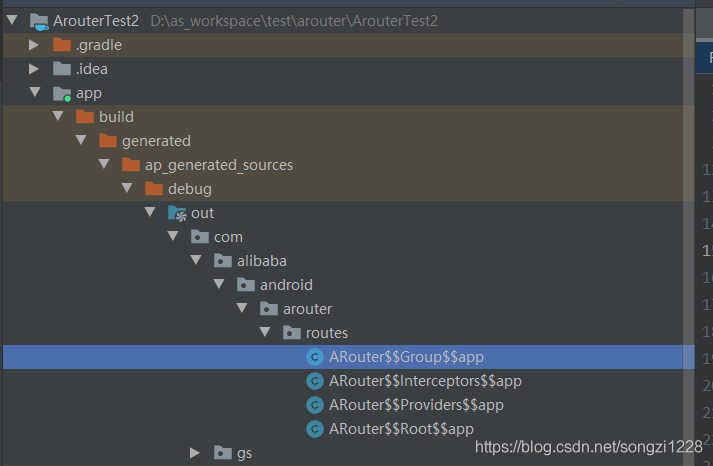
既然生成了这些源码,我们就先随便点点看看这些都是啥?
/**
DO NOT EDIT THIS FILE!!! IT WAS GENERATED BY AROUTER. */
public class ARouter
app implements IRouteGroup {
@Override
public void loadInto(Map<String, RouteMeta> atlas) {
atlas.put("/app/Test1Activity", RouteMeta.build(RouteType.ACTIVITY, Test1Activity.class, "/app/test1activity", "app", null, -1, -2147483648));
atlas.put("/app/Test2Activity", RouteMeta.build(RouteType.ACTIVITY, Test2Activity.class, "/app/test2activity", "app", new java.util.HashMap<String, Integer>(){{put("test", 10); put("name", 8); put("age", 3); }}, -1, -2147483648));
atlas.put("/app/Test3Activity", RouteMeta.build(RouteType.ACTIVITY, TestInterceptorActivity.class, "/app/test3activity", "app", null, -1, -2147483648));
}
}
/**
DO NOT EDIT THIS FILE!!! IT WAS GENERATED BY AROUTER. */
public class ARouter
app implements IRouteRoot {
@Override
public void loadInto(Map<String, Class<? extends IRouteGroup>> routes) {
routes.put("app", ARouter
app.class);
}
}
具体源码大家可以自行查看,不过多粘贴了。
这里简简单单随便截图了 APT 生成的部分源码,是不是感觉跟上一篇文章使用到的代码很多相似性呐~比如拦截器的优先级是 1、跳转匹配的路径也是一样的、跳转传递的参数、定义的组名等等。既然这么多一样的那肯定是在内部某部分进行封装使用,带着这个问题我们开始逐步分析。
首先,我们从该框架使用到的注解开始分析(因为注解是使用这个框架的起点)
2.1、注解分析
首先,我们知道要使用 ARouter 的首先需要在类的注释上面写上 @Route 这个注解,点进源码看看
@Target({ElementType.TYPE})
@Retention(RetentionPolicy.CLASS)
public @interface Route {
String path();
S
tring group() default "";
String name() default "";
int extras() default Integer.MIN_VALUE;
int priority() default -1;
}
使用该注解标注的类将被自动添加至路由表中。而且,ARouter 并非仅提供页面(Activity)的路由功能,还可以用来路由模块想要暴露给其他模块调用的接口。也就是说?@Route?不仅可用于 Activity 类,还可用于模块对外接口的实现类。那么具体它可以实现那些类型?
从上面的源码可以看到,除了拦截器,里面通过实现接口重写方法,方法里面都有一个 RouteMeta,那么我们点进去 RouteMeta 这个类看看:
/**
It contains basic route information.
*/
public class RouteMeta {
private RouteType type; // Type of route
private Element rawType; // Raw type of route
private Class<?> destination; // Destination
private String path; // Path of route
private String group; // Group of route
private int priority = -1; // The smaller the number, the higher the priority
private int extra; // Extra data
private Map<String, Integer> paramsType; // Param type
private String name;
private Map<String, Autowired> injectConfig; // Cache inject config.
public RouteMeta() {
}
}
注释的意思是:它包含基本路由信息。
RouteType,就是路由的类型。那么,这款路由框架的具体路由类型又有那些?带着这个疑问,点进 RouteType?源码看看。
public enum RouteType {
ACTIVITY(0, "android.app.Activity"),
SERVICE(1, "android.app.Service"),
PROVIDER(2, "com.alibaba.android.arouter.facade.template.IProvider"),
CONTENT_PROVIDER(-1, "android.app.ContentProvider"),
BOARDCAST(-1, ""),
METHOD(-1, ""),
FRAGMENT(-1, "android.app.Fragment"),
UNKNOWN(-1, "Unknown route type");
}
首先这是一个枚举,这些就是框架可以具体使用到的路由类型
说完 Route 这个注解,我们在来看看 @Interceptor?拦截器注解,
@Target({ElementType.TYPE})
@Retention(RetentionPolicy.CLASS)
public @interface Interceptor {
/**
The priority of interceptor, ARouter will be excute them follow the priority.
*/
int priority();
/**
The name of interceptor, may be used to generate javadoc.
*/
String name() default "Default";
}
哦,我们发现拦截器的注解就 2 个方法,第一个是定义优先级的,第二个就是拦截器的名字。
接着,@Autowired 注解:
@Target({ElementType.FIELD})
@Retention(RetentionPolicy.CLASS)
public @interface Autowired {
// Mark param's name or service name.
String name() default "";
// If required, app will be crash when value is null.
// Primitive type wont be check!
boolean required() default false;
// Description of the field
String desc() default "";
}
我们知道这个注解是界面跳转时参数传递用的。Activity 中使用该注解标志的变量,会在页面被路由打开的时候自动赋予传递的参数值。
2.2、初始化分析
我们知道,ARouter 框架使用的第一个步骤,是要先初始化,也就是调用:ARouter.init( Application.this );这个 API,那么,它的初始化究竟是做了那些东西?我们先点进源码看看:
/**
Init, it must be call before used router.
*/
public static void init(Application application) {
if (!hasInit) {
logger = _ARouter.logger;
_ARouter.logger.info(Consts.TAG, "ARouter init start.");
hasInit = _ARouter.init(application);
if (hasInit) {
_ARouter.afterInit();
}
_ARouter.logger.info(Consts.TAG, "ARouter init over.");
}
}
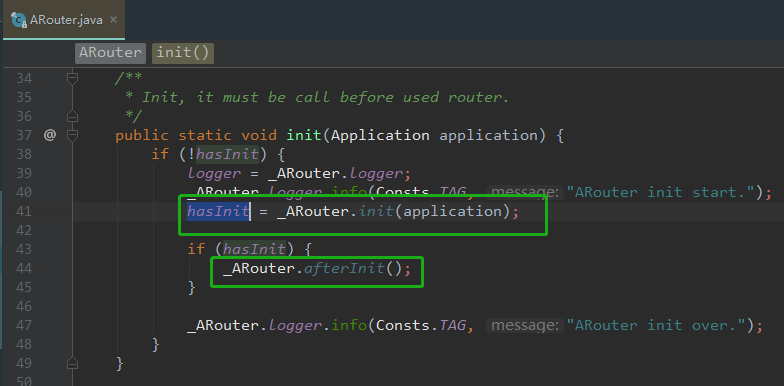
那么,实际上它调用的是绿色矩形内的代码,绿色矩形内有两个初始化,一个是?_ARouter.init(application),还有一个是 _ARouter.afterInit( )。
我们首先点进 **_ARouter . init()**看看,
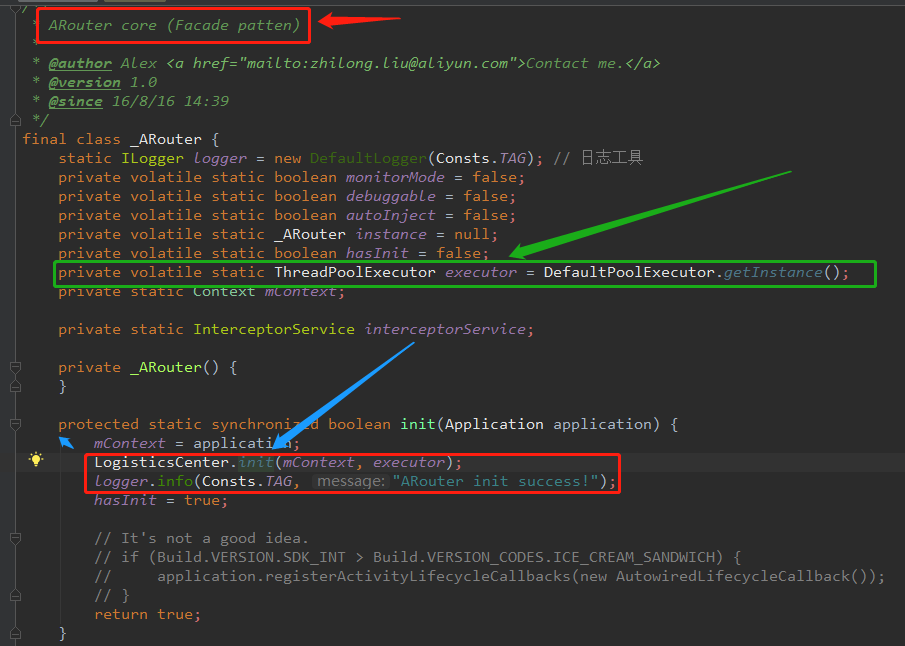
A:红色箭头的是类注释,翻译过来就是:ARouter 核心( 外观模式 )
B:绿色箭头代表的是一个线程池,对线程池概念不是很清楚的朋友可以点进?[必须要理清的 Java 线程池](
)?先了解一下
C:蓝色箭头代表的是 这个_ARouter init()实际是调用的 LogisticsCenter 里面的 init 方法。
首先,什么是外观模式?
简单点理解就是,通过创建一个统一的类,用来包装子系统中一个或多个复杂的类,客户端可以通过调用外观类的方法来调用内部子系统中所有方法。大概意思就是这样,想深入理解的话可以自行查阅资料。
其次,这个线程池做了什么功能?
点进去 DefaultPoolExecutor 这个类看看:
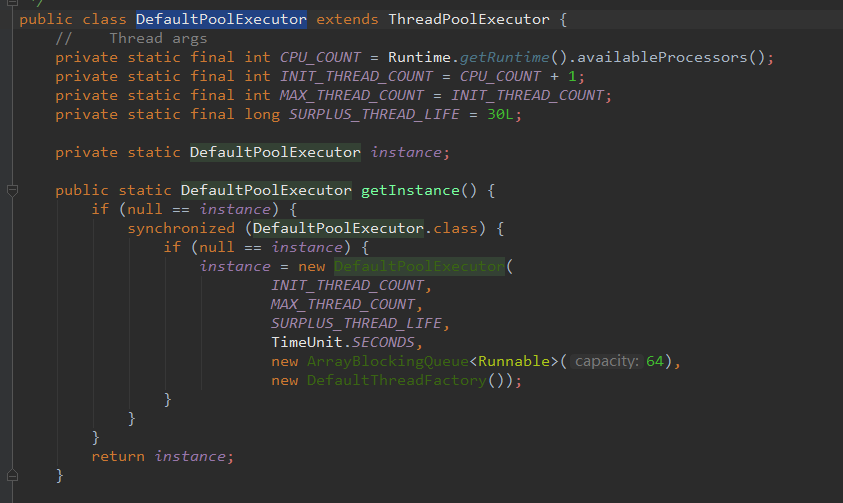
由源码得知就是创建了一个数组阻塞队列的线程池
最后,我们点进 LogisticsCenter,看看里面的 init 方法执行了什么操作(因为源码太长,我就分别截图)
图一:
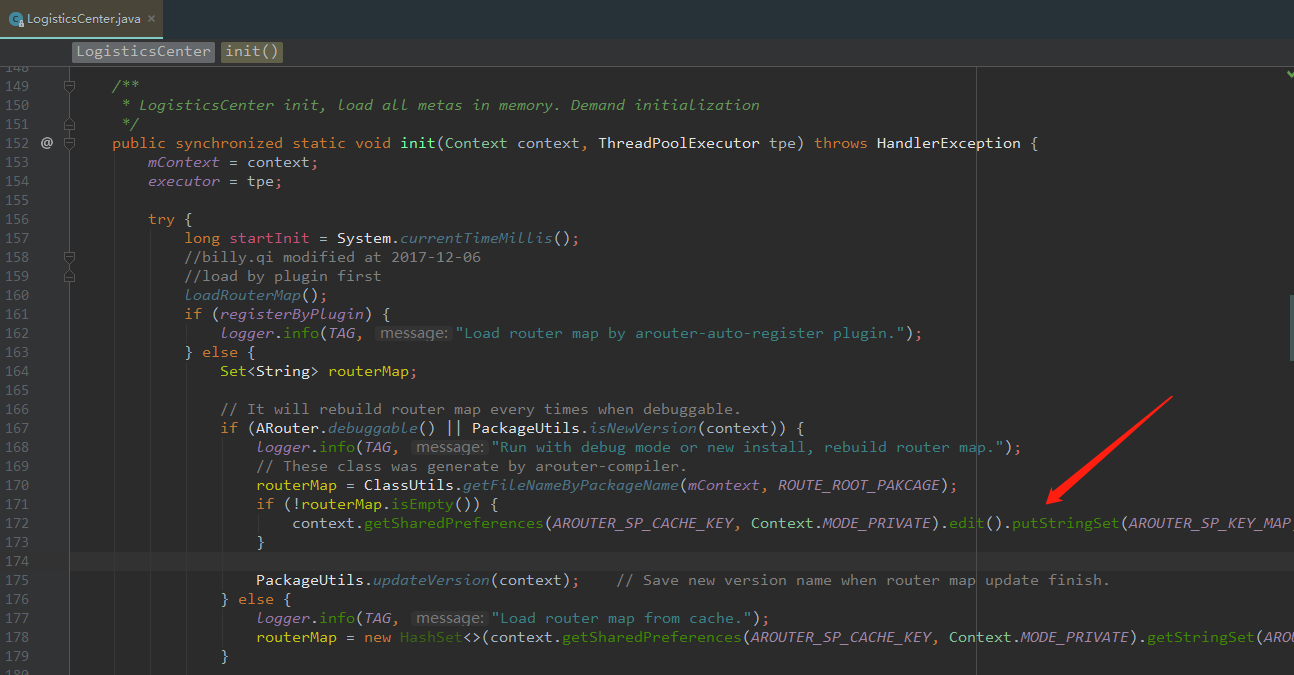
图二:
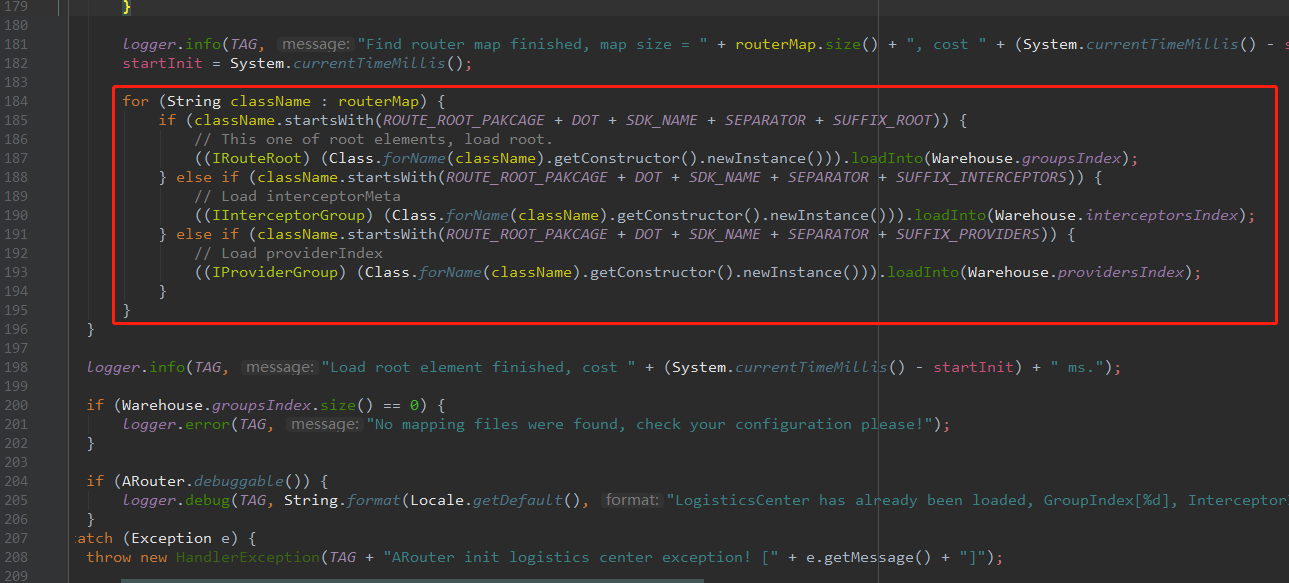
通过 LogisticsCenter - init(1)这幅源码图可以得知:如果是 Debug 模式,则执行从 if 代码块; 如果是 Release 模式:通过 PackageUtils.isNewVersion(context)判断当前应用是否是第一次启动。接着,获取 arouter-compiler 生成的文件,然后将该文件,存储在 sp 中,下次启动应用的时候,直接从 sp 缓存中读取。
然后,在 LogisticsCenter - init(2)红色矩形的代码块可以得知:首先遍历 arouter-compiler 生成的文件,将他们按照类型分别存储到 Warehouse 的对应字段中。也就是,如果类名前缀符合文件拼接规则,比如为 com.alibaba.android.arouter.routes.ARouter$$Root 的文件,就将其添加到具体的 Warehouse 里面的集合中。也就是对应的这里
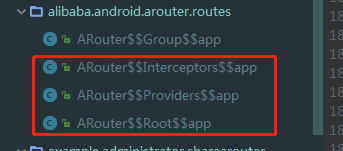
那么,这个文件拼接规则(也就是字符串拼接)是?
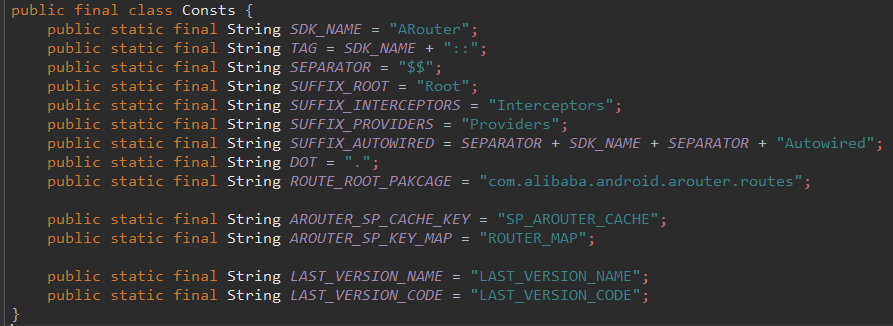
Warehouse 又是什么?点进源码看看
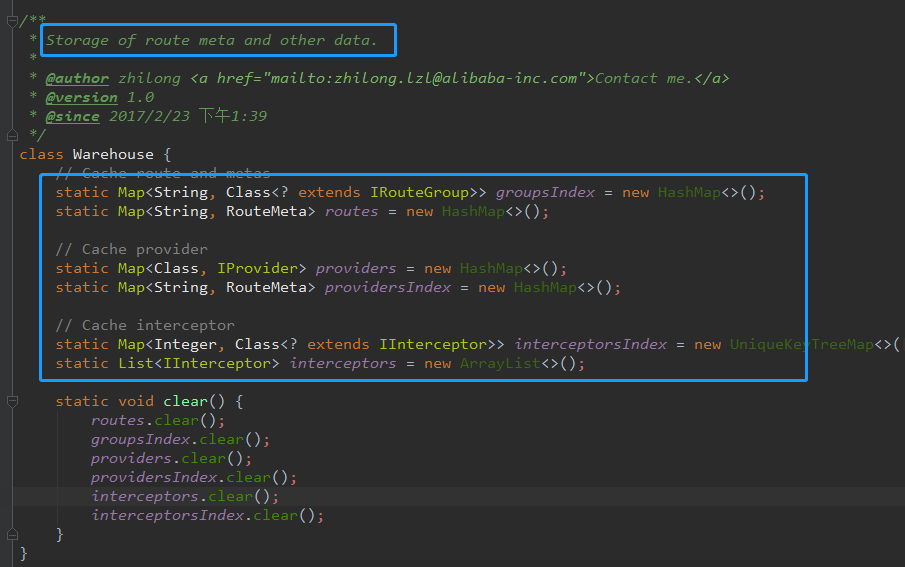
其中,Warehouse 的类注释写的非常好,翻译过来就是:路由元数据和其他数据的存储。这个类本质就是路由文件映射表。里面提供了各种 HashMap 集合(Map 不允许重复的 key),去存储 SP 存储的值。
我们再看看这里存储拦截器的集合,UniqueKeyTreeMap,这个类是存储拦截器的,我们看看它做了什么?
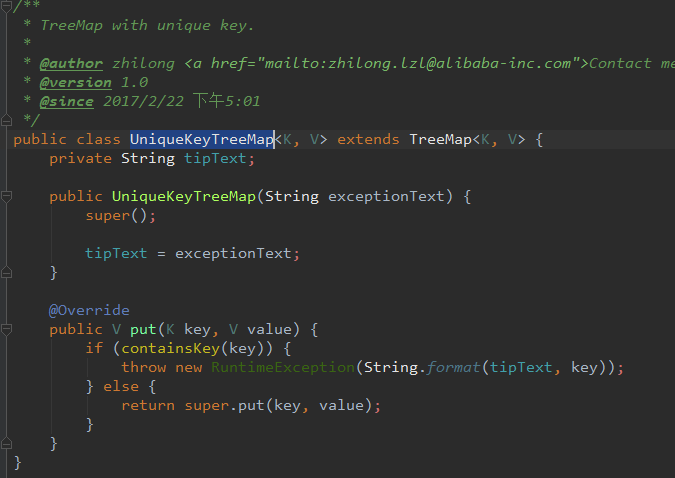
原来,这个 UniqueKeyTreeMap,就是继承了 TreeMap,哦,我们知道 TreeMap 是一种有序的集合(底层帮我们排序)所以数值越小,它就优先添加拦截器。这样也就解释了为什么拦截器属性值设置的越低,优先级越高。
综上,针对?_ARouter init( )?这个初始化的源码我们可以得知以下:
A:初始化这一操作,表面上是_ARouter ,实则是 LogisticsCenter 在帮我们管理逻辑
B:LogisticsCenter 内部通过先存储 SP,然后遍历、匹配(满足条件则添加到具体的集合中,按照文件的前缀不同,将他们添加到路由映射表 Warehouse 的 groupsIndex、interceptorsIndex、providersIndex?中)
C:具体的路由清单是 Warehouse ,不仅保存实例,还给我们提供了缓存。也就是说?同一个目标(RouteMeta、IProvider、IInterceptor)仅会在第一次使用的时候创建一次,然后缓存起来。后面都是直接使用的缓存。
初始化还有一个 API,_ARouter.afterInit( ) ; 这个 API 在上面的截图也有,那么这个 API 是用来干什么的?我们点进去看看。

首先,它实例化了一个 InterceptorService。这里的 InterceptorService 下面会说。 这里的 build 方法,最终返回的是一个 Postcard 对象:
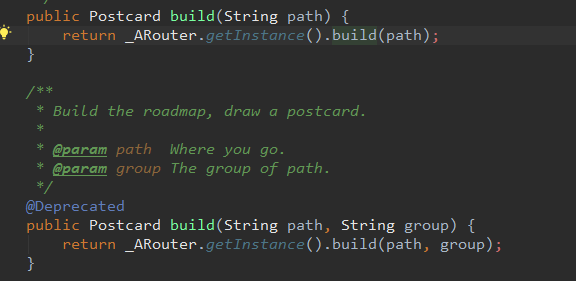
从源码可以得知,实际上它返回的却是,_ARouter.getInstance().build(path)这个方法,这个方法是一个方法重载(一般用的最多的就是这一个,也就是默认分组,不进行自定义分组),跟进去看看(源码很长,分为以下两个截图):
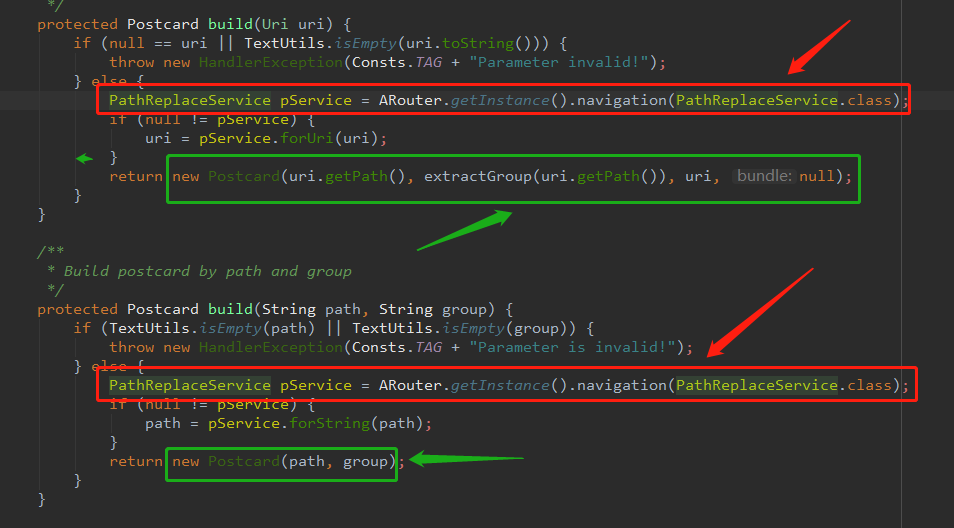

发现这里有一个 PathReplaceService(也就是红色矩形),这个 PathReplaceService 又是什么,点进去看看
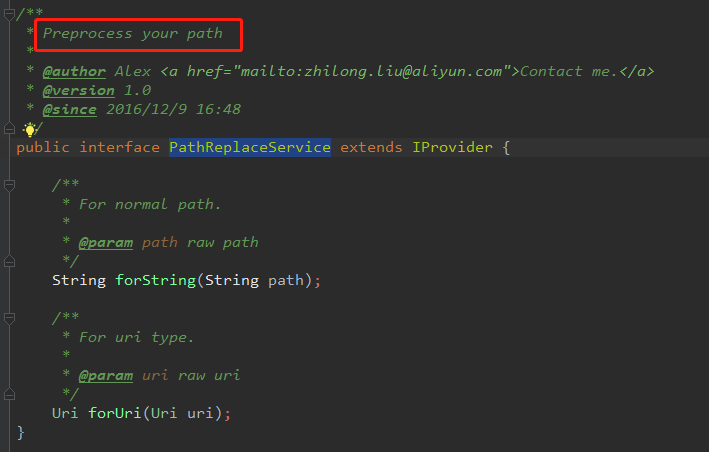
这个类注释翻译过来就是:预处理路径。这个接口是 IProvider 的子类
让我们在看回绿色箭头,其中,navigation(clazz)这种方式是属于根据类型查找,而 build(path)是根据名称进行查找。如果应用中没有实现 PathReplaceService 这个接口,则 pService=null。PathReplaceService 可以对所有的路径进行预处理,然后返回一个新的值(返回一个新的 String 和 Uri)。绿色箭头有一个 extractGroup()方法,点进去看看:
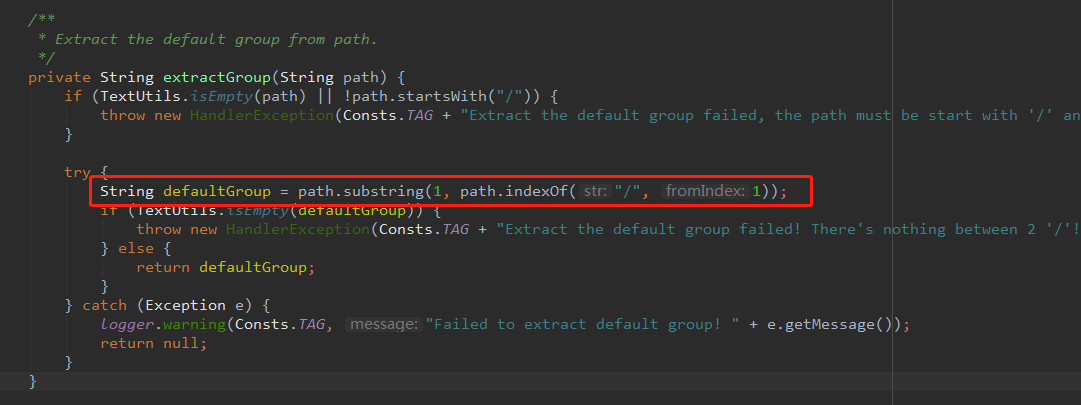
extractGroup(path)这个方法,核心逻辑是红色矩形内的代码,这个方法主要是获取分组名称。切割 path 字符串,默认为 path 中第一部分为组名。这就证明了如果我们不自定义分组,默认就是第一个分号的内容。
分析完了 build,我们在看看 navigation
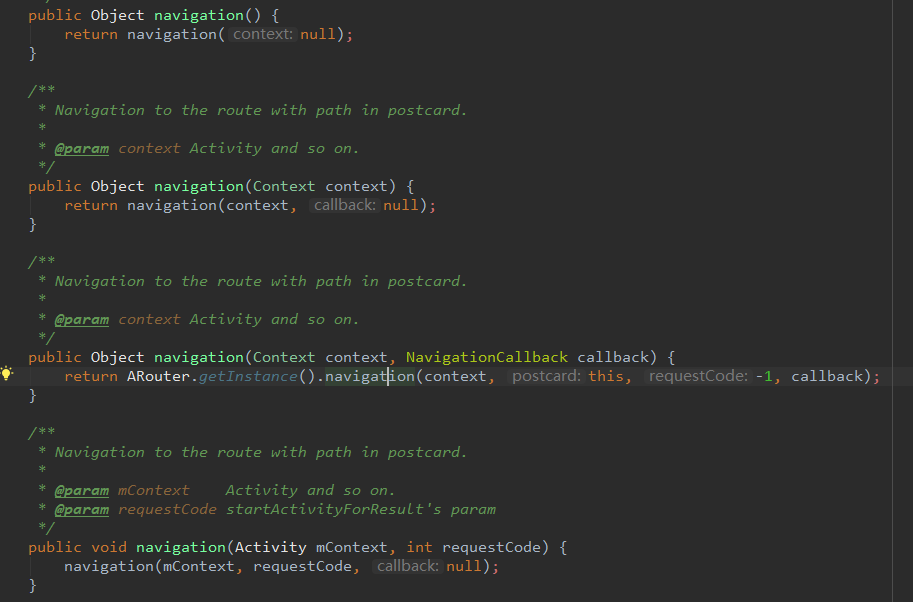
继续点进源码看看,发现进入了_ARouter 这个类里面的 navigation 方法:
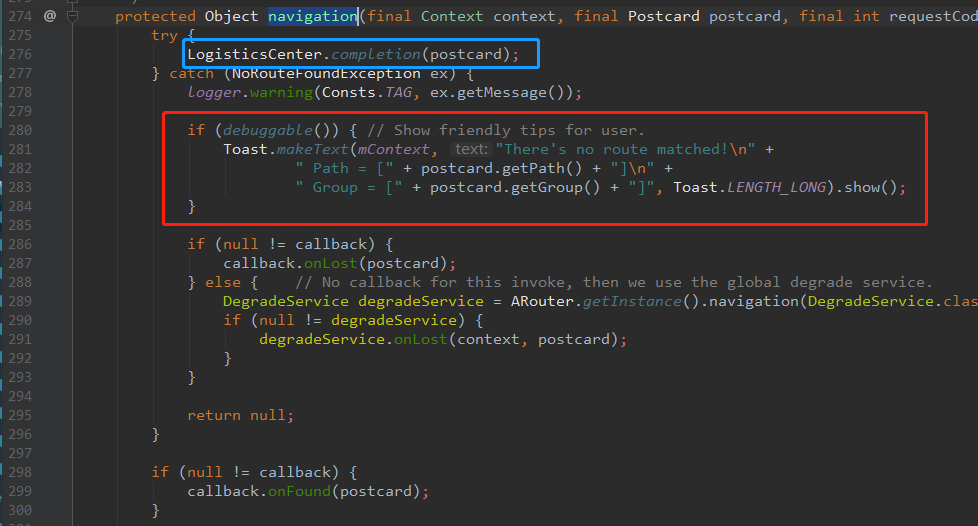

其中,navigation - 1 这幅图中的红色矩形代表的意思是,如果(两个)路径没写对,ARouter 会 Toast 提示客户端,路径不对。
navigation - 2 这幅图中的红色矩形代表的是忽略拦截器。interceptorService 实例化对象的时机,是在_ARouter 这类中的 afterInit( )进行实例化的。这幅图中的蓝色矩形和箭头的方法真实逻辑是调用了下图的方法:
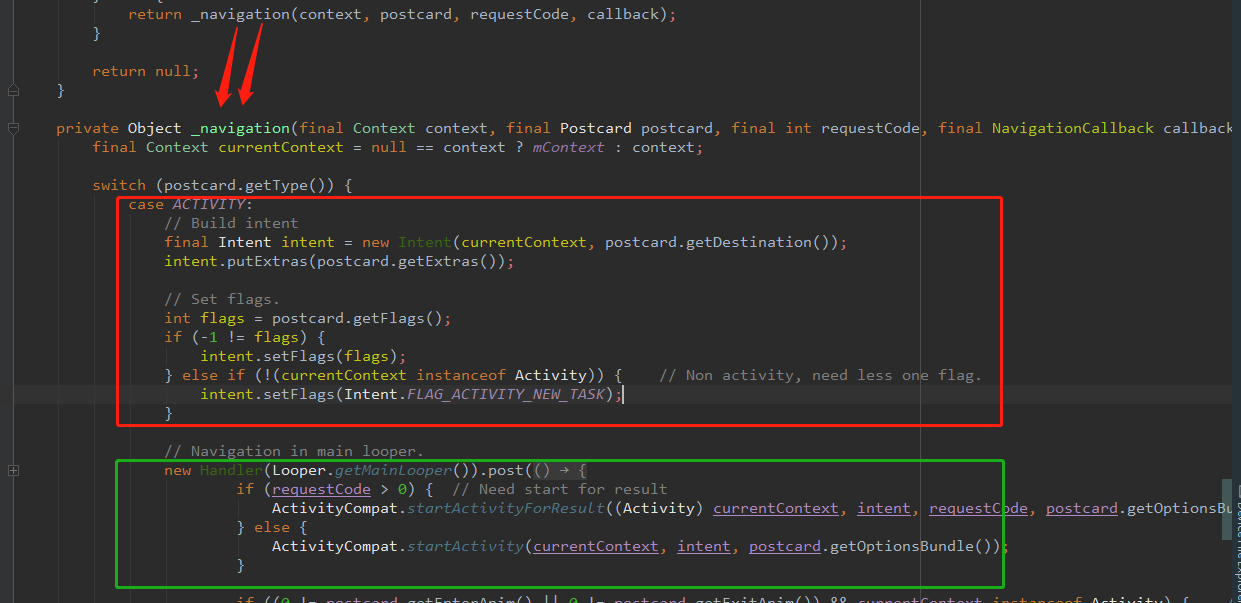
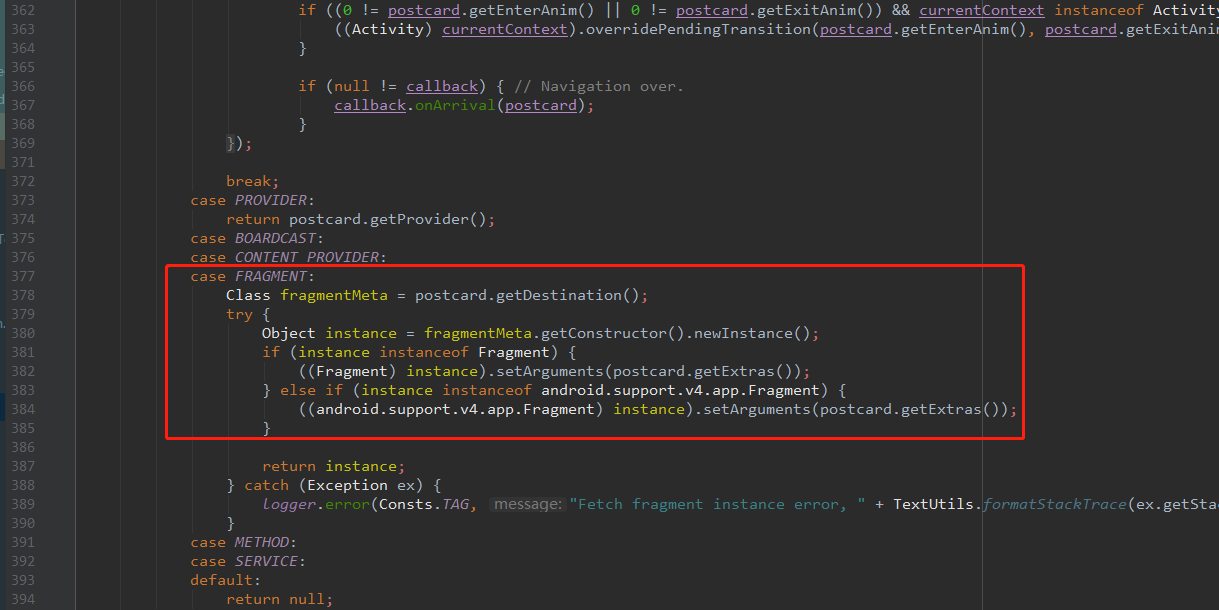
通过这段代码我们可以得知:












评论